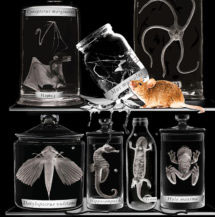
Formaldehyde, or formalin, is well known to all of us as a common chemical used in many industrial processes and also as a preservative, remarkably we also produce formaldehyde in our bodies. This “endogenous” formaldehyde is ubiquitous, and sufficient amounts might be produced that could damage our cells. Work by Lucas Pontel and Ivan Rosado in KJ Patel’s group, in the LMB’s PNAC Division, uncovers a fundamental mechanism used by mammals to protect against endogenous formaldehyde, and they also reveal the striking longstanding damage caused when this protection fails.
Endogenous formaldehyde is produced by numerous biochemical pathways fundamental to life but it can also crosslink both DNA and proteins, however the consequences of its accumulation were until now unclear. KJ’s group shows that endogenous formaldehyde is usually removed by the enzyme alcohol dehydrogenase 5 (Adh5). Collaborative work with James Swenberg’s group, of the Gillings School of Public Health, University of North Carolina Chapel Hill, showed that when endogenous formaldehyde is not removed it damages DNA. This DNA damage is repaired by the Fanconi system of DNA repair that has previously been shown by KJ’s group to correct damage caused by acetaldehyde, a known breakdown product of alcohol. This provides a two-tier protection mechanism (the formaldehyde removing enzyme – Adh5 and the Fanconi Anaemia repair factor – Fancd2).
Using mice as a model organism, the group found that mice that lacked both the Adh5 and also Fancd2, rapidly died after birth because they could no longer produce blood. This was because endogenous formaldehyde destroyed the blood stem cells residing in the bone marrow. In addition, severe DNA damage also caused the cells of the liver and the kidney to fail. Bone marrow transplantation with normal mouse bone marrow prolonged the life of these genetically altered formaldehyde unprotected mice. This was due to the rescue of their damaged bone marrow, however ensuing formaldehyde damage led to the development of fatal cancers.
This study reveals that naturally produced formaldehyde is a common source of endogenous DNA damage that can cause important organ systems to fail, and also drive changes that cause cancer. This new knowledge has implications for human health: children effected by the cancer and bone marrow failure syndrome Fanconi anaemia are unable to repair the DNA damage caused by formaldehyde. In these patients reducing or counteracting endogenous formaldehyde production may be of therapeutic value. Furthermore, this discovery settles a long standing controversy on formaldehyde as an industrial and environmental carcinogen, for it is not exposure to this ubiquitous toxin that causes damage but that which is produced naturally within our bodies that is damaging.
This work was funded by the MRC, the Wellcome Trust, CRUK and NIEHS.
Further References
Paper in Molecular Cell
KJ’s Group Page
James Swenberg’s Group
Insight on Research – Alcohol by product destroys blood stem cells